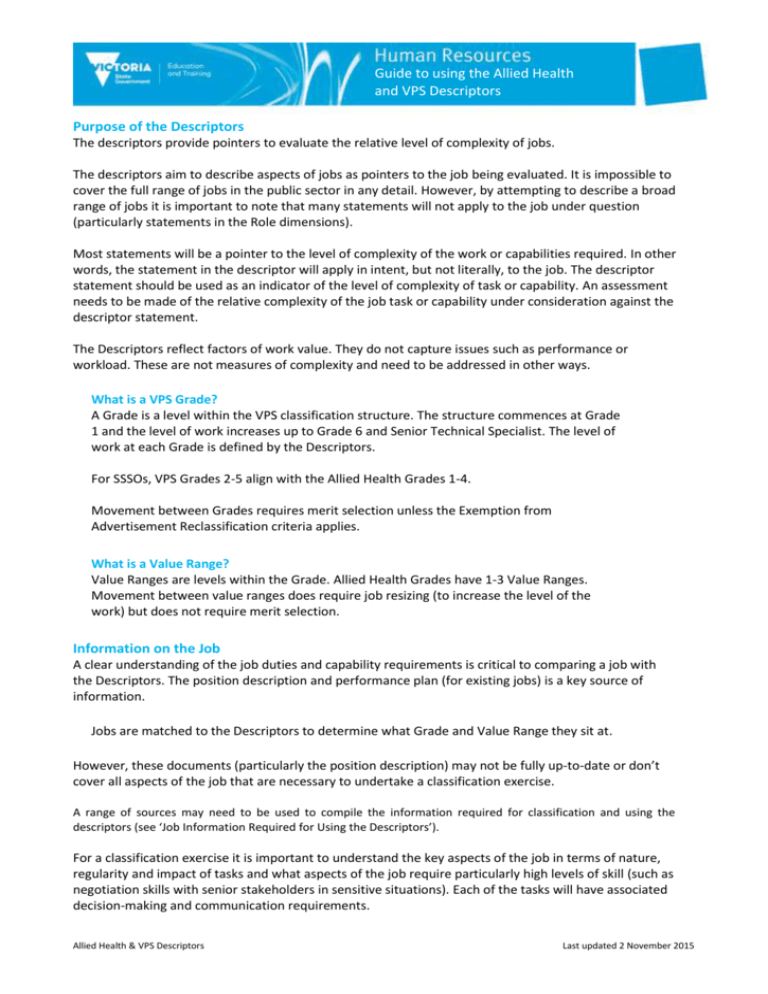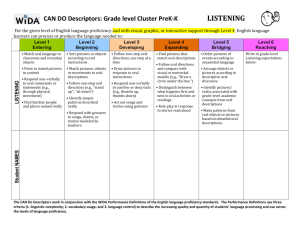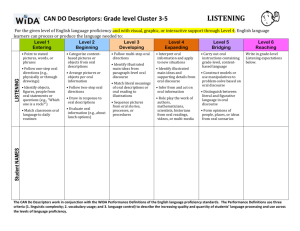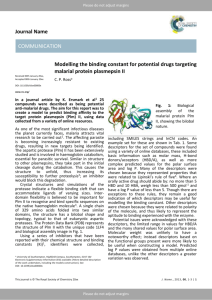WORD - Department of Education and Early Childhood Development
advertisement

Guide to using the Allied Health and VPS Descriptors Purpose of the Descriptors The descriptors provide pointers to evaluate the relative level of complexity of jobs. The descriptors aim to describe aspects of jobs as pointers to the job being evaluated. It is impossible to cover the full range of jobs in the public sector in any detail. However, by attempting to describe a broad range of jobs it is important to note that many statements will not apply to the job under question (particularly statements in the Role dimensions). Most statements will be a pointer to the level of complexity of the work or capabilities required. In other words, the statement in the descriptor will apply in intent, but not literally, to the job. The descriptor statement should be used as an indicator of the level of complexity of task or capability. An assessment needs to be made of the relative complexity of the job task or capability under consideration against the descriptor statement. The Descriptors reflect factors of work value. They do not capture issues such as performance or workload. These are not measures of complexity and need to be addressed in other ways. What is a VPS Grade? A Grade is a level within the VPS classification structure. The structure commences at Grade 1 and the level of work increases up to Grade 6 and Senior Technical Specialist. The level of work at each Grade is defined by the Descriptors. For SSSOs, VPS Grades 2-5 align with the Allied Health Grades 1-4. Movement between Grades requires merit selection unless the Exemption from Advertisement Reclassification criteria applies. What is a Value Range? Value Ranges are levels within the Grade. Allied Health Grades have 1-3 Value Ranges. Movement between value ranges does require job resizing (to increase the level of the work) but does not require merit selection. Information on the Job A clear understanding of the job duties and capability requirements is critical to comparing a job with the Descriptors. The position description and performance plan (for existing jobs) is a key source of information. Jobs are matched to the Descriptors to determine what Grade and Value Range they sit at. However, these documents (particularly the position description) may not be fully up-to-date or don’t cover all aspects of the job that are necessary to undertake a classification exercise. A range of sources may need to be used to compile the information required for classification and using the descriptors (see ‘Job Information Required for Using the Descriptors’). For a classification exercise it is important to understand the key aspects of the job in terms of nature, regularity and impact of tasks and what aspects of the job require particularly high levels of skill (such as negotiation skills with senior stakeholders in sensitive situations). Each of the tasks will have associated decision-making and communication requirements. Allied Health & VPS Descriptors Last updated 2 November 2015 The next step is to determine if the job has similarities (for classification purposes) to any generic or benchmark job descriptions that have been established in the department or agency. If the job aligns on all key dimensions of the position description then it is probably a good frame of reference for the classification. If there are any differences it is best to do a test classification. It is important to recognise that jobs can do similar tasks but operate differently in terms of decisionmaking, communication and knowledge and proficiency. Therefore, a job that does not align closely with all aspects of the generic job description should be independently classified. Following the classification exercise, it is important to check back to the generic descriptors and their classification to ensure the correct relativities. Measures of Complexity Many people consider jobs in terms of duties or tasks. However, it is the measures of how complex these tasks are that are relevant to classification. In the Descriptors, complexity has been measured in terms of Decision-Making, Communication, Knowledge and Proficiency and functions of the role. The level at which these dimensions are exercised determines the relative complexity of jobs, regardless of the differences in tasks between jobs. Reading the Descriptors Holistically The Value Range needs to be read holistically and this can change the meaning of some of the individual statements. For example, references to leading or managing teams need to be read in context of the complexity of the functions in the team. The position may lead a team that is responsible for senior policy advice or technical expertise and this may require high level decision making, communication and expertise skills that aren’t equivalent to the Value Range that emphasises team leadership (VPS Grade 4 rather than a VPS Grade 3 team leader for example). A position may involve relatively complex tasks (for example, in VPS Grade 3 Value Range 1) but the high level of supervision and low level of authority may decrease the importance of the tasks and favour a classification in VPS Grade 2. In these sorts of examples it is difficult to weight the importance of the different dimensions. However, it is important that the classification reflects the overall complexity and that jobs should not be under classified by relying on specific statements in the lower Value Range in isolation. Classification Assessment – ‘On Balance’ The descriptors should be applied so that, ‘on balance’, it can be shown that the job sits at the Grade and Value Range. For Over Grade Reviews the position only needs to be at the level of the Grade. The following paragraphs explain general classification requirements in terms of narrowing classification to a Value Range but the comments equally apply to Grades. The Value Ranges build on each other – so that successive Value Ranges presume the job includes work and capabilities at the lower Value Ranges. Therefore, jobs will tend to be spread across Value Ranges and Grades. In order to identify the appropriate classification the assessor needs to work out the highest Value Range that, ‘on balance’ describes the job. It is unlikely that the majority of the job will fall in the highest applicable Value Range or Grade. A job in Value Range 2 is likely to have many applicable statements also in Value Range 1 (because this is how they’ve been designed). Therefore, the applicable Value Range may describe less than half the job. Allied Health & VPS Descriptors Page 2 Tips for Using the Descriptors Use the Descriptors to determine the classification for the job ‘on balance’ Many statements won’t be relevant to the type of job and therefore don’t apply Some statements won’t directly apply to the job but provide an indication of what level of work is expected at that classification The dimensions need to be read in context of each other and shouldn’t be applied in isolation Each Value Range builds on the preceding ones and many statements at lower ranges will also be applicable to the job – but aren’t relevant to classification The definition of some words is contextual e.g. a work unit may mean different things in different organisations The appropriate Value Range is the highest Value Range that describes a ‘significant’ part of the job. It is feasible that some statements in a higher Value Range will be relevant to the job but will not be sufficient to classify the job at that level. A ‘significant’ part of the job includes tasks or capabilities that are: High impact Significant proportion of the job High volume (regular etc) Based on a specific skill only applicable to the higher Value Range Inclusion of a task or capability in the performance plan or job description would normally be an indication that the requirement is significant. Benchmark jobs at the same classification level may give some indication of the types of tasks or capabilities that are required to be classified at that level. A task or capability is unlikely to be ‘significant’ if it is not normally expected of the employee (e.g. because they are filling in for someone else) or is a clearly defined ‘developmental’ activity (see below). These sorts of activities should be limited in frequency and duration. Unfortunately, there is no common rule that can cover all situations. If the decision about classification is borderline an assessment will need to be made on the basis of the specific facts. Contact your region to discuss your specific situation. Developmental Tasks Employees are often given an opportunity to assist in higher level tasks for their own development and to prepare them for the next level. Tasks may be developmental if the employee is fully supervised and not responsible for outcomes. A clear example is when employees are invited to observe activities but don’t participate. However, if they are regular or a feature of the job they should be a factor to be considered in classification. VALIDATION CHECKS Relative Classification in the Hierarchy In general, the level of supervision and available advice is a key factor in ascertaining classification. A key component of work level complexity is the level of responsibility the employee has for the outputs of themselves (and others). Hence the work may be inherently complex but advice and guidance is readily Allied Health & VPS Descriptors Page 3 available for complex decision making or the employee is not responsible for the decision (in that case, usually made by the manager). Therefore, the hierarchical context of the position is ascertained by the level of supervision, responsibility and autonomy and is a key factor in the overall level of complexity of the work. This explains a general principle of classification – that each level of hierarchy increases in classification (a manager is usually classified higher than their subordinates). Another contributing factor to this principle is that the breadth of the job is a key factor in ascertaining the level of work complexity. As the breadth of knowledge or responsibility increases, so does the classification. So, if all else is equal, an employee that has expertise in two narrow areas of specialty has a higher classification than an employee with just one of the areas of expertise. In many instances, a manager must have strong familiarity with all of the specialty areas covered by their subordinates (not necessarily to the same depth level as each subordinate). In addition, they have a higher level of responsibility for decision-making across each of these areas. Therefore, hierarchy – in the sense of steps in level of breadth, autonomy, responsibility and expertise is a good test for a classification outcome. Does the result of the classification exercise sit above the classification level of any subordinates and below the level of the manager? As this is not a hard and fast rule (in some extreme circumstances the depth of expertise could be so strong as to equal the breadth and responsibility of a manager) it is important that hierarchy be used to test after the classification exercise is done. It should not constrain thinking whilst the classification exercise is being done. Relativity with Similar Jobs The classification system maintains an intricate web of relativities between jobs of different sizes. Therefore, it is important to test the outcome of any classification exercise against related jobs or other jobs in the team (or similar teams elsewhere in the organisation). If the outcome does not seem right against other jobs then it may help to do a comparative classification exercise and determine if parts of either job have been overstated or understated. Alternatively, relativity problems (particularly in relation to the direct hierarchy of the job) may indicate a problem in the job design. Each level of the hierarchy should usually represent a distinct step up in work complexity, particularly in relation to responsibility and breadth. Allied Health & VPS Descriptors Page 4 AN OVERVIEW OF THE DIMENSIONS OF THE JOB DECISION-MAKING Decision-making captures the dimensions of the role related to the need to exercise judgement and responsibility for decision-making. Judgement is constrained by the extent to which there are pre-existing rules, guidelines, processes and policies. Where these are comprehensive and directive the job requires little exercise of judgement. In many cases, employees must choose between prescribed options and the extent to which the choice is also prescribed (e.g. in situation A choose option 1, in situation B choose Option 2 etc) will determine the level of complexity. A moderately high level of judgement would be required where the job regularly deals with unusual situations in which there are many options to choose from and the choice of option is not clear. The highest level of judgement is required when many aspects of a job are not governed by existing precedent or policy (such as a scientist entering an uncharted field of expertise). Sometimes the decision may be complex by virtue of the nature and scope of the information required to make the decision. It may require a high level of judgement when the information or advice is conflicting or sensitive. Decision-making also includes the level of accountability for decisions and outcomes and the authority to make decisions on the process or strategy for their work. For classification purposes the employee is held accountable when the decision is not usually questioned at a higher level or does not require prior approval before going ahead with implementation. Some experts may provide technical advice that is not questioned because of the authority of the expertise that the individual has. The impact of the decision is of critical importance to the assessment of complexity. An employee that has delegation to purchase stationery does not have the same level of authority as an employee authorised to manage employees. COMMUNICATION Communication refers to the broad requirement for interpersonal skills that include leadership, persuasion, explanation and negotiation. This job dimension captures the type of stakeholders and the complexity of their interests. Stakeholders refer to any individual or group that has an interest or stake in the outcomes of the job. This can include clients, member of the public, department employees, service providers and agencies, member of government or the public service, unions, businesses or the media. If there are numerous stakeholders with conflicting objectives that need to be managed as part of the job, or the stakeholders are critical to the overall objectives of the department then the job will be more complex. Explanation of complex or sensitive ideas may make the job more complex. Many jobs have to communicate difficult information but this may be routine and within prescribed parameters. Communication of a decision is easier if there is a clear policy or procedure that can be explained and relied upon. On the other hand, communication of unprecedented decisions requires higher communication skills to explain concepts and a rationale. Even higher skills are required to communicate technical concepts to ‘lay’ stakeholders. Allied Health & VPS Descriptors Page 5 Persuasion is more advanced than the exchange of ideas. It requires the skill to construct an argument intended to influence the thinking of others (it is not relevant whether the object of the persuasion is won over). Except at the higher levels of classification, it is not necessarily expected that the thinking of others will be under the control of an employee. Rather, it implies the use of skills that are objectively understood to influence others in the right situation. Negotiation combines the skills of persuasion with the authority to make representations on behalf of the department and agree to proposals from other parties. KNOWLEDGE AND PROFICIENCY Knowledge and Proficiency reflects the skills, knowledge and experience required to perform the role. The complexity is inherent in the nature and depth of the knowledge and proficiency. Highly technical expertise rates highest in terms of complexity. It is important to note that the minimum knowledge and proficiency required to perform the role is relevant, not the knowledge and proficiency held by the occupant of the job. However, if the knowledge and proficiency of the incumbent is utilised to the advantage of the employer then it effectively becomes part of the requirements of the role. Skills are often learned on-the-job or through life experience (such as interpersonal skills). General skills, such as use of standard technology, are often assumed in jobs and due to their prevalence do not rate highly in terms of complexity. More specific, technical skills will often be a factor in determining work complexity (such as advanced data analysis or modelling). Knowledge covers both practical and theoretical. Practical knowledge is usually gained on-the-job and includes knowledge of policies, processes, legislation and concepts in the applicable profession. As the knowledge grows more conceptual (such as knowledge of policies or professional concepts) or technical it tends to increase in complexity. An increase in depth of knowledge also tends to increase complexity. At lower levels employees have a basic or general understanding of policies, legislation and concepts. The application of these concepts would be restricted (as for application of options in relation to judgement – see above). At higher levels interpretation of these instruments is required and later, some capacity to modify the relevant concepts. At the most expert levels employees would question, modify or create the concepts and policies based on their in-depth knowledge of the field. Theoretical knowledge is usually gained and demonstrated through formal study and certification. In general, the application of theoretical concepts will add to the complexity of a role but this will largely depend upon the complexity of the concepts to be applied. THE ROLE The role captures the type of activities covered by the Allied Health Adaptive classification Structure and may contain some aspects of public sector roles. Public Sector Roles have one or more of the following groups of activities - Policy and Projects, Administrative and Corporate Support, Operational Service Delivery and Technical/ Specialist. The tasks described within each of the activities provide a sample of the breadth and depth of tasks to be performed. In general, operational tasks (such as direct service delivery) are less complex than strategic activities (such as broad policy development); managerial activities are more complex; and technical and specialist roles are more complex than general roles. This is largely based on the level of decision-making, communication and knowledge and proficiency required. An increase in breadth (range and variety of tasks) or depth (level of expertise) will generally result in a higher classification. However, in the case of a technical or specialist role the knowledge and proficiency requirements may be so great that great depth in a relatively narrow area of expertise will still warrant a high classification (up to and including senior technical specialist). Allied Health & VPS Descriptors Page 6 JOB INFORMATION REQUIRED FOR USING THE DESCRIPTORS Information on Job Authority, delegations and level of autonomy Types of decisions and judgements to be made Framework for decisions Requirement for innovation Stakeholders Interpersonal Skills Technical skills and knowledge Theoretical knowledge Examples What decisions are authorised to be made independently in the job? Does the job have any formal delegations? Is the employee constantly, moderately or rarely formally supervised in relation to key tasks? Do the decisions require complex thought processes? Are the decisions sensitive or contentious? Do the decisions vary and have little precedence? Do prescriptive procedures, legislation or regulations apply to the job? Does the application of procedures, legislation, regulation or policies require interpretation? Is interpretation based on precedent? Is the job required to make decisions or take initiative outside the rules and guidelines? Is there scope for innovation? What stakeholders does the job interact with, including: Ministers/ government; Other employees external to the team; Management; Clients; Businesses, service agencies and industry bodies; and Media and general public? Does the role require leadership of others (management, mentoring, supervision etc) Does the job require specific practical skills that have been learnt on the job? Does the job require knowledge of theoretical concepts (such as those acquired in formal qualifications)? Attributes What values are required in the job What personal attributes are required? Type and Volume of Tasks What are the key tasks in terms of impact and volume? How do these tasks relate to the job context in terms of decision-making, communication and knowledge and proficiency? Allied Health & VPS Descriptors Application to the Descriptors Decision-Making – level of responsibility Decision-Making - complexity Decision-Making – frameworks and constraints on decision making Decision-Making – freedom to decide Innovation and Originality Communication – requirement for communication and interpersonal skills Role sub-dimensions – tasks interacting with stakeholders Communication – leadership and interpersonal skills Knowledge and Proficiency – practical skills and knowledge Knowledge and Proficiency – theoretical knowledge and concepts The Role: Technical/ Specialist – application of theoretical and technical concepts and procedures These are implicitly referred to in Innovation and in Knowledge and Proficiency but aren’t an explicit requirement for using the Descriptors The Role: Policy and Projects; Administrative and Corporate Support; Operational Service Delivery; Technical/ Specialist Page 7







